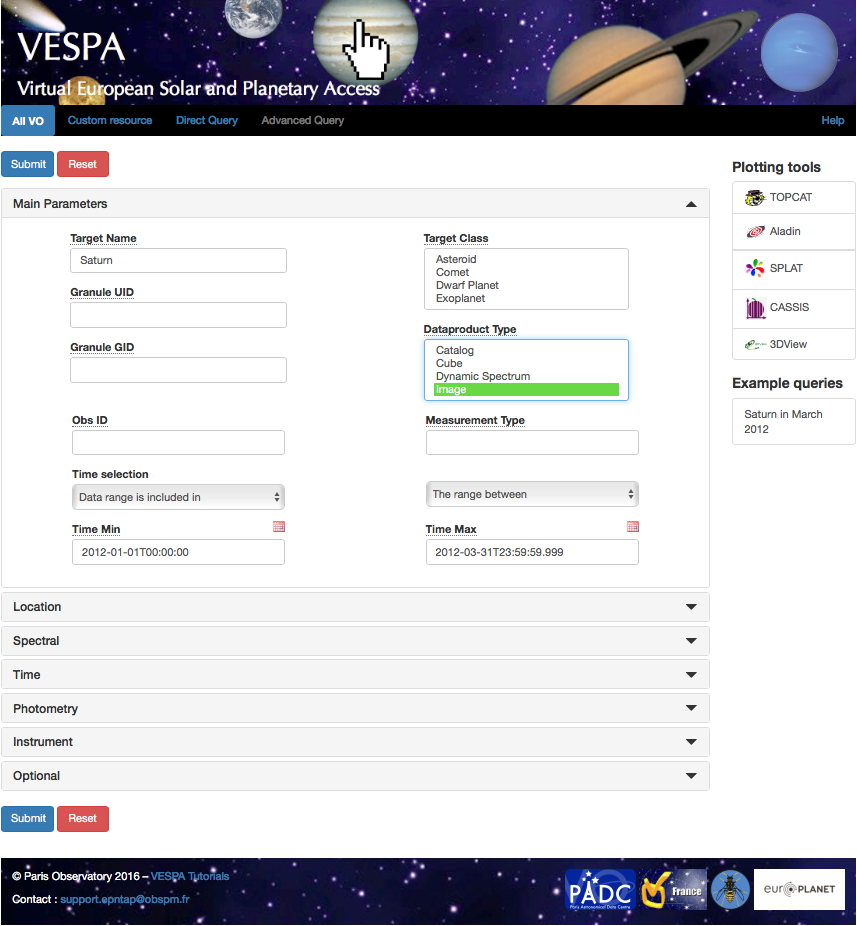VESPA: Why would you care?
Modern ground based and space borne instruments produce huge datasets, especially on long-lived missions such as Mars-Express. This calls for new ways to handle the data, not only to perform massive processing, but also more basically to access them easily and efficiently. Planetary science will be facing big data challenges and opportunities in these years.
VESPA: What is this?
Virtual Observatory (VO) techniques developed in Astronomy during the past 15 years can be adapted to address this problem, provided they are extended to include specificities of Solar System studies such as coordinate systems, target-related time scales, or measured quantities.
An effort to adapt VO techniques to Solar System studies has been started in the frame of the Europlanet program, first in FP7 (2009-2012) as a demonstrator, and now in Horizon2020 (2015-2019) in a more extensive way.
In the current program Europlanet 2020, the VESPA (Virtual European Solar and Planetary Access) activity deals with the infrastructure and implementation new data services. VESPA supports all aspects of Solar System science. Its developments are building upon the standards of the IVOA (International Virtual Observatory Alliance).
VESPA is proposing a consistent and comprehensive set of methods to distribute and search for data ressources. One of the main added value is its unified interface to search for solar system data resources.
VESPA: discovering and sharing
A new version of the main VESPA query portal has recently been released. It provides direct access to all connected databases and the possibility to retrieve data files based on location, time, observing conditions, viewing geometry, etc. It also allows the user to easily examine and possibly analyze most data on-line with Virtual Observatory tools.

Currently 25 database are connected, covering all fields of Planetary Science, including surfaces, atmospheres, plasma, small bodies, exoplanets, etc, from a distributed network of data providers in 4 different European countries and Japan.
Some well attended services can be accessed this way, e.g., the Encyclopedia of Exoplanets in Paris Observatory (~ 250,000 visits in 2016). Two other data services selected during the 2016 VESPA call are being connected and will be available in the coming weeks (from Granada and Kharkiv). In addition, one service from a network of amateur observers (RadioJove) has been installed.
The number of data services available will rapidly grow in the coming year, as the VESPA Data Access Protocol (EPN-TAP v.2) has been adopted by ESA to provide access to its Planetary Science Archive, and is being studied by NASA and other space agencies. This system is also open to contributions from research teams. Teams which need support to implement their data service can apply to the 2017 VESPA call next December. Selected teams will be invited to a 4 days workshop in Graz next March.
The SSHADE activity is also proceeding towards a large public spectroscopy service. The database is being filled with laboratory measurements, and will be connected to the VESPA search interface later this year after validation.
Alternative access to VESPA-compliant data services is possible from VO tools such as 3Dview and CASSIS, and an EpnTAPClient java library is available for developers.
The VESPA coordination team
Stéphane Erard, Angelo Pio Rossi, Baptiste Cecconi, Maria Teresa Capria
More info on VESPA
Credits
VESPA is a workpackage of the Europlanet 2020 Research Infrastructure project. It has received funding from the European Union’s Horizon 2020 research and innovation programme under grant agreement No 654208.